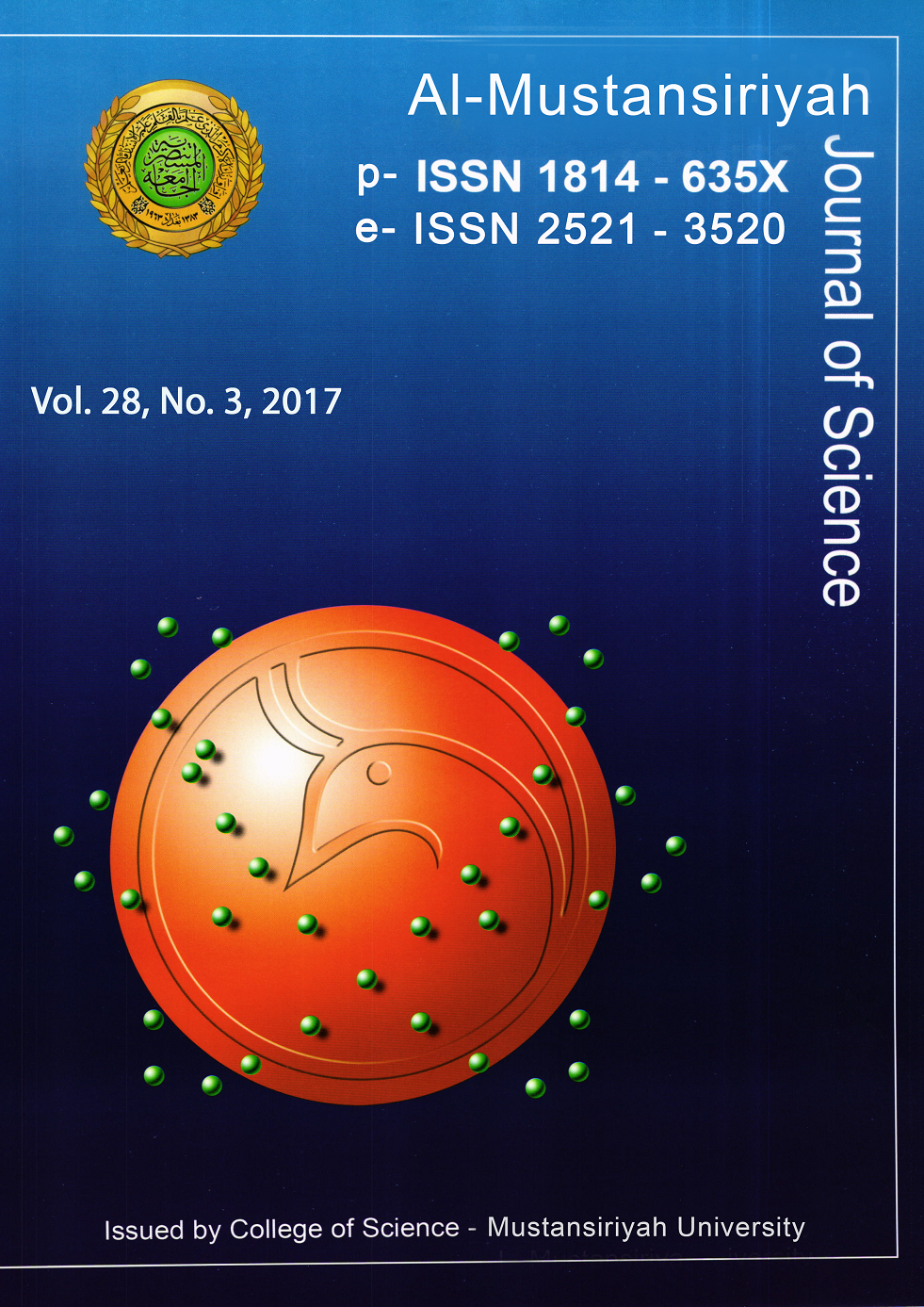Effect of chelating compounds (DTPA) and Brassinolide on some vegetative growth characteristics and macroelement content in Corianderum sativum L.
DOI:
https://doi.org/10.23851/mjs.v28i3.123Abstract
The study was conducted at the Botanical Garden for Department of Biology, College of Education for Pure Science (Ibn Al-Haitham), University of Baghdad for the growing season (2016-2017) in order to study the chelating compound DTPA effect at different concentrations (0, 5, 10, 15, 20) mg.L-1 and growth organizer brassinolide at concentrations (0, 0.5, 1, 1.5, 2) mg.L-1 and their interaction on some morphological properties and content of macroelement (nitrogen, phosphorus, potassium) for coriander plant. Randomized complete Block Design (RCBD) was tested with three replicates. The results showed that the application by (DTPA) act to an increase in the mean of stem diameter and the total chlorophyll content in the leaves and concentration of nitrogen and potassium at the concentration of 20 mg.L-1 while no a significant effect on phosphorus concentration compared to the control treatment. Brassinolide increased all the studied characteristics of stem diameter, total chlorophyll content in leaves, concentration of nitrogen and concentration of potassium at concentration of 2 mg.L-1, while it did not have a significant effect in phosphorus concentration compared to control treatment.
The results also showed a significant interaction between the factors of experiment in all the studied characteristics at the concentrations 20 mg.L-1 from DTPA and 2 mg.L-1 from brassinolide except of phosphorous which showed a significant interaction at concentrations 20 mg.L-1 from DTPA and 1, 1.5 mg.L-1 from brassinolide.
Downloads
References
Jimenez-Medina. A new extract of the plant calendula officinalis produces a dual invitro effect: cyto and toxic anti-tumor activity and lymphocyte activiation. BMC. Cancer, 6: 119-132. 2006.
Nadeem, M.; Anjum, F. M., Khan, I. M., Tehseen , S. , El‐Ghorab , A. and Sultan , I. J. Nutritional and medicinal aspects of coriander (Coriandrum sativum L.): A review. British Food J., 155(5): 743-755. 2013.
Nithya, T.G. and Sumalatha, D. Evaluation of in vitro-oxidant and anticancer activity of Coriandrum sativum against human, mnb colon cancer HT-29 cell lines. Inter. J. Pharm. and Pharmac. Sci., 6(2): 421 -424. 2014.
Mathe, A. Medicinal and Aromatic Plants of the World, Scientific, Production, Commercial and Utilization Aspects. Springer Science+Business Media Dordrecht. 460 pp. 2015.
Al-Adami, Z. A. A. Studies on the effect of some factors affecting iron readiness in sedimentation and structure. Master thesis, College of Agriculture and Forestry, University of Mosul. 1981.
Islam, T. M. Mammalian hormones in plant and their roles in plant,peronosporomycetes interaction. Curr. Topics Phytochem., (12):89-106. 2014.
Hayat, S. and Ahmad, A. (2011). Brassinosteroids: A class of plant hormone. Springer, London. UK. 2011.
Mussig, C. Brassinosteroid-promoted growth. Plant Biol., 7:110-117. 2005.
Page, A. L.; Miller, R. H. and Kenney, D. R. Method of Soil Analysis 2nd edn. Agron. 9 publisher, Madiason. Wisconsin. U.S.A. 1982.
Gresser, M. S. and J. W. Sulphuric, perechloric and digestion of plant material for magnesium. Analyt. Chem. Acta, 109: 431-436. 1979.
Jackson, M. L. Soil Chemical analysis prentice. Hall Inc. Englewood, Cliffs, N. T., USA. 1958.
Olsen, S. K. and Sommers, L. E. Phosphorus In: Page, A. L.et al. (eds.) Mcthods of soil analysis. Amer. Agron. Inc., Madison, Wisconsin, New York. 1982.
Chapman, H. D. and Pratt P. F. Methods of analysis for Soils, Plant and Water. Univ. Calif Div. Agric. Sci., USA.33-35. 1961.
SAS. Statistical Analysis System, User's Guide. Statistical. Version 9.1th ed. SAS. Inst. Inc. Cary. N.C. USA. 2012.
Awad, M. M. and Atawia, R. A. Effect of foliar sprays with some micronutrients on tree growth and leaf mineral content. Annals Agric. Sci. 40(1): 359 -367. 1995.
Al-Jubouri, W. S. H. Effect of Gaberlin and Preclinolide in some growth and yield properties of two Anethum gravelens L. MSc. Thesis, College of Education for Pure Science (Ibn Al-Haitham), University of Baghdad. 2017.
Shahbaz, M. and Ashraf, M. Influence of exogenous application of Brassinosteroid on growth and mineral nutrients of wheat (Triticum aestivum L.) under saline conditions. Pak. J. Bot., 39: 513-522. 2007.
Abu Dhahi, Y. M. and Al Yunis, M. A. 1988. Guide to plant nutrition. Ministry of Higher Education and Scientific Research. University of Mosul - Iraq. 1988.
Fariduddin, Q.; Ahmad, A. and Hayat, S. Photosynthetic response of Vigna radiata to pre-sowing seed treatment with 28- homobrassinolide. Photosynthetica, 41: 307-310. 2003.
Swamy, K. N. and Rao, S. S. R. Effect of 24-epibrassinolide on growth, photosynthesis, and essential oil content of Pelargonium graveolens L. Herit. Russ. J. Plant Physiol., 56(5): 616-620. 2009.
Bera, A. K.; Maity, U. and Mazumdar, D. Effect of foliar application of brassinolide and salicylic acid on NPK content in leaf and nutritive values of seed in green gram (Vigna radiata L. Wil Czek). Legume Res., 31 (3): 169-173. 2008.
Verma, A.; Malik C. P.; Sinsinwar Y. K. and Gupta V. K. Yield Parameters Responses in a Spreading (ev. M-13) and Semi-Spreading (ev. Girnar-2) Types of Groundnut to six Growth Regulators. American-Eurasian J. Agric. and Environ. Sci., 6(1): 88-91. 2009.
Downloads
Key Dates
Published
Issue
Section
License
(Starting May 5, 2024) Authors retain copyright and grant the journal right of first publication with the work simultaneously licensed under a Creative Commons Attribution (CC-BY) 4.0 License that allows others to share the work with an acknowledgement of the work’s authorship and initial publication in this journal.






















